Content
- Project understanding
- Objectif
- Practice skills
- Python packages to be applied
- Data description
- Data cleaning
- Data analysis
- Train models
- Reference
Project understanding
Ask a home buyer to describe their dream house, and they probably won’t begin with the height of the basement ceiling or the proximity to an east-west railroad. But this playground competition’s dataset proves that much more influences price negotiations than the number of bedrooms or a white-picket fence.
With 79 explanatory variables describing (almost) every aspect of residential homes in Ames, Iowa, this competition challenges you to predict the final price of each home.
Objectif
It is your job to predict the sales price for each house. For each Id in the test set, you must predict the value of the SalePrice variable.
Practice skills
- Creative feature engineering
- Advanced regression techniques like random forest and gradient boosting
Python packages to be applied
import pandas as pd
import numpy as np
import matplotlib.pyplot as plt
import seaborn as sns
from scipy.stats import skew, boxcox_normmax
from scipy.special import boxcox1p
from sklearn.model_selection import train_test_split, KFold, cross_val_score
from sklearn.metrics import mean_squared_error
from sklearn.base import BaseEstimator, TransformerMixin
from sklearn.pipeline import Pipeline, FeatureUnion, make_pipeline
from sklearn.impute import SimpleImputer
from sklearn.preprocessing import LabelEncoder, StandardScaler, RobustScaler
from sklearn.linear_model import LinearRegression, Ridge, Lasso, ElasticNet, ElasticNetCV, LassoCV, RidgeCV
from sklearn.svm import SVR, LinearSVR
from sklearn.ensemble import GradientBoostingRegressor
from xgboost import XGBRegressorData description
print('Dimension train_df:', train_df.shape)
print('Dimension test_df:', test_df.shape)
# Dimension train_df: (1460, 81)
# Dimension test_df: (1459, 80)
train_df.info()
# <class 'pandas.core.frame.DataFrame'>
# RangeIndex: 1460 entries, 0 to 1459
# Data columns (total 81 columns):
# Id 1460 non-null int64
# MSSubClass 1460 non-null int64
# MSZoning 1460 non-null object
# LotFrontage 1201 non-null float64
# LotArea 1460 non-null int64
# Street 1460 non-null object
# Alley 91 non-null object
# LotShape 1460 non-null object
# LandContour 1460 non-null object
# Utilities 1460 non-null object
# LotConfig 1460 non-null object
# LandSlope 1460 non-null object
# Neighborhood 1460 non-null object
# Condition1 1460 non-null object
# Condition2 1460 non-null object
# BldgType 1460 non-null object
# HouseStyle 1460 non-null object
# OverallQual 1460 non-null int64
# OverallCond 1460 non-null int64
# YearBuilt 1460 non-null int64
# YearRemodAdd 1460 non-null int64
# RoofStyle 1460 non-null object
# RoofMatl 1460 non-null object
# Exterior1st 1460 non-null object
# Exterior2nd 1460 non-null object
# MasVnrType 1452 non-null object
# MasVnrArea 1452 non-null float64
# ExterQual 1460 non-null object
# ExterCond 1460 non-null object
# Foundation 1460 non-null object
# BsmtQual 1423 non-null object
# BsmtCond 1423 non-null object
# BsmtExposure 1422 non-null object
# BsmtFinType1 1423 non-null object
# BsmtFinSF1 1460 non-null int64
# BsmtFinType2 1422 non-null object
# BsmtFinSF2 1460 non-null int64
# BsmtUnfSF 1460 non-null int64
# TotalBsmtSF 1460 non-null int64
# Heating 1460 non-null object
# HeatingQC 1460 non-null object
# CentralAir 1460 non-null object
# Electrical 1459 non-null object
# 1stFlrSF 1460 non-null int64
# 2ndFlrSF 1460 non-null int64
# LowQualFinSF 1460 non-null int64
# GrLivArea 1460 non-null int64
# BsmtFullBath 1460 non-null int64
# BsmtHalfBath 1460 non-null int64
# FullBath 1460 non-null int64
# HalfBath 1460 non-null int64
# BedroomAbvGr 1460 non-null int64
# KitchenAbvGr 1460 non-null int64
# KitchenQual 1460 non-null object
# TotRmsAbvGrd 1460 non-null int64
# Functional 1460 non-null object
# Fireplaces 1460 non-null int64
# FireplaceQu 770 non-null object
# GarageType 1379 non-null object
# GarageYrBlt 1379 non-null float64
# GarageFinish 1379 non-null object
# GarageCars 1460 non-null int64
# GarageArea 1460 non-null int64
# GarageQual 1379 non-null object
# GarageCond 1379 non-null object
# PavedDrive 1460 non-null object
# WoodDeckSF 1460 non-null int64
# OpenPorchSF 1460 non-null int64
# EnclosedPorch 1460 non-null int64
# 3SsnPorch 1460 non-null int64
# ScreenPorch 1460 non-null int64
# PoolArea 1460 non-null int64
# PoolQC 7 non-null object
# Fence 281 non-null object
# MiscFeature 54 non-null object
# MiscVal 1460 non-null int64
# MoSold 1460 non-null int64
# YrSold 1460 non-null int64
# SaleType 1460 non-null object
# SaleCondition 1460 non-null object
# SalePrice 1460 non-null int64
# dtypes: float64(3), int64(35), object(43)
# memory usage: 924.0+ KBData cleaning
There are missing data in “LotFrontage”, “Alley”, “MasVnrType”, “MasVnrArea”, “BsmtQual”, “BsmtCond”, “BsmtExposure”, “BsmtFinType1”, “BsmtFinType2”, “Electrical”, “FireplaceQu”, “GarageType”, “GarageYrBlt”, “GarageFinish”, “GarageQual”, “GarageCond”, “PoolQC”, “Fence” and “MiscFeature”.
Among these fields,
- 94% data of “Alley” are missing.
- 47% data of “FireplaceQu” are missing.
- 99.5% data of “PoolQC” are missing.
- 81% data of “Fence” are missing.
- 96% data of “MiscFeature” are missing.
So we will ignore them during the analysis.
What should we do on missing data of other fields? We might replace null by median value or mode value.
Data analysis
Relationship between “SalePrice” and numeric fields
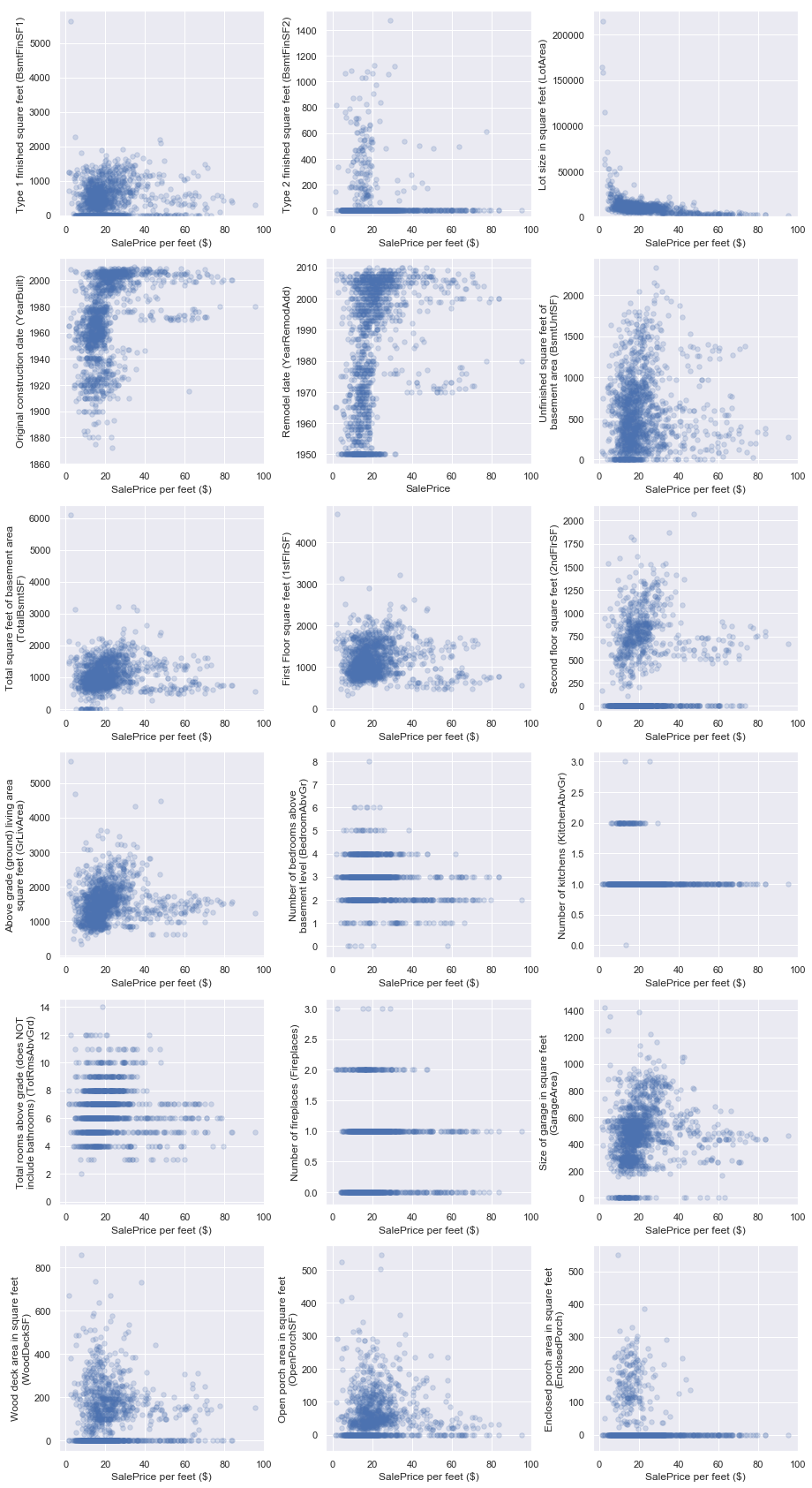
I take parts of numeric values, show the relationship between “SalePrice per square feet” and each of them:
- The more recent construction / remodel is, the higher “SalePrice per square feet” is.
- The more total rooms above grade is, the higher “SalePrice per square feet” is.
- The larger lot size (LotArea) is, the cheaper “SalePrice per square feet” is.
- For the lot whose total basement area is not larger than 40 square feet, the larger total basement area is, the cheaper “SalePrice per square feet” is; for the lot whose total basement area is larger than 40 square feet, the “SalePrice per square feet” is between 500$ and 2000$. For the lot whose above grade (groud) living area is not larger than 40 square feet, the large above grade (groud) living area is, the higher “SalePrice per square feet” is; for the lot whose above grade (ground) living area is larger than 40 square feet, the “SalePrice per square feet” is between 500$ and 2000$.
- Etc.
Relationship between “SalePrice_per_squareFeet” and category fields
“SalePrice_per_squareFeet” vs. “1MSSubClass”
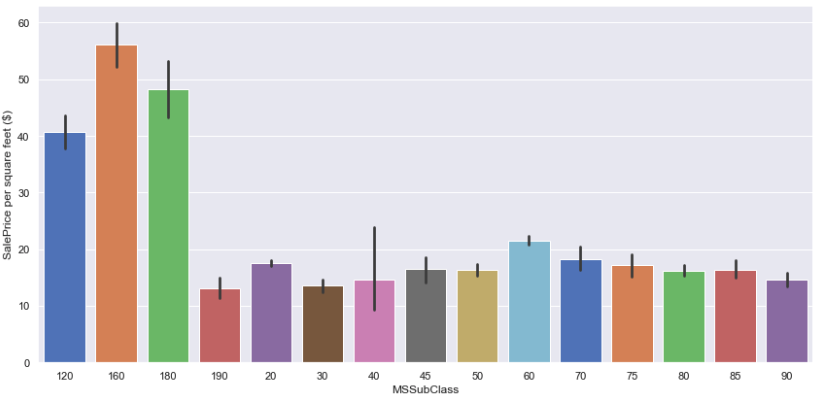
Among all building classes, the first three most expensive classes are “2-STORY PUD - 1946 & NEWER”, “PUD - MULTILEVEL - INCL SPLIT LEV/FOYER” and “1-STORY PUD (Planned Unit Development) - 1946 & NEWER”.
“SalePrice_per_squareFeet” vs. “MSZoning”
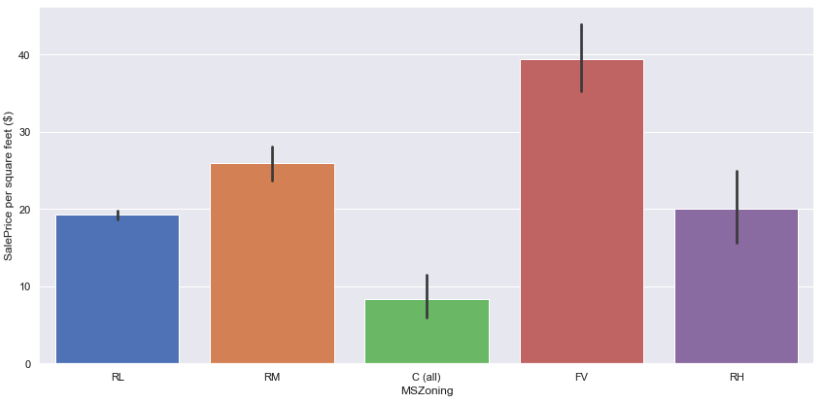
The graph above studies the sale price per square feet in terms of general zoning classification. Among these 5 zoning classes, the sale price per square feet of “Floating Village Residential (FV)” is the most expensive, the zoning classes which are less expensive are “Residential Medium Density (RM)”, “Residential High Density (RH)” and “Residential Low Density (RL)”, the sale price per square feet of “Commercial (C)” is the cheapest among the 5 classes.
Considering the construction’s difficulty and their rarity, we can obviously understand why the sale price per square feet of “Floating Village Residential (FV)” is the most expensive. However, there are less restrictions on the “Commercial” class, so it’s the cheapest class.
“SalePrice_per_squareFeet” vs. “LotShape”
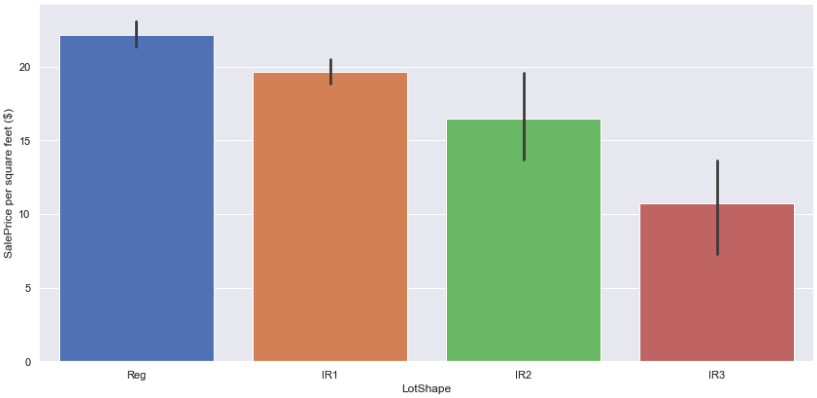
The relationship between General shape of property (LotShape) and the sale price per square feet is easily to understand: people usually like regular shape (Reg) of property, since it’s simple for the overall arrangement and more comfortable for living.
“SalePrice_per_squareFeet” vs. “Utilities”

The result of this plot is interesting: we all know the more complete utilities are, the more expensive per square feet is. Except this point, we also get the price per square feet of a property whose all public utilities are available is double of the square feet-price of a property that only electricity and gas are available.
“SalePrice_per_squareFeet” vs. “LotConfig”
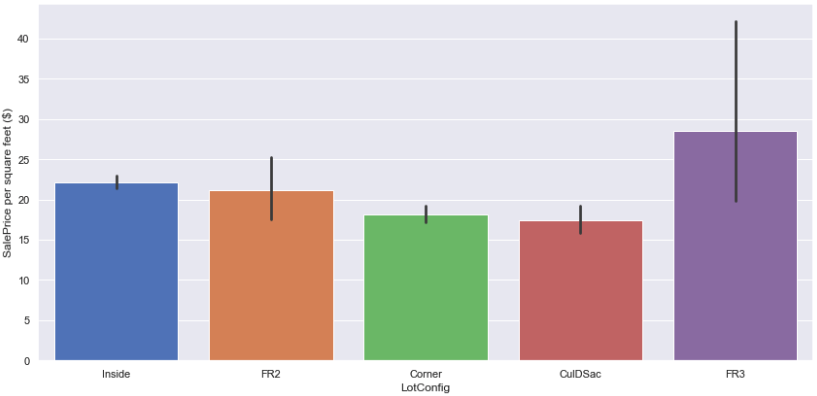
Considering the lightness, the ventilation and the view, the lot with “Frontage on 3 sides of property” is the best, so its price per square feet is the most expensive among the 5 configurations. On the contrary, the lot which is located as a Cul-de-sac, its price per square feet is the cheapest.
“SalePrice_per_squareFeet” vs. “Neighborhood”
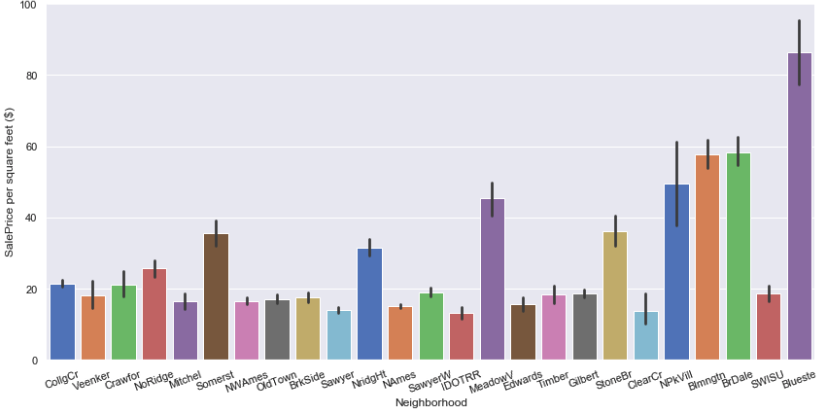
Considering the economic / political / geographical reasons, if a lot is located near Bluestem, its price per square feet is nearly 90 dollars; moreover, if the lot is located near Bloomington Heights or Briardale, its price per square feet is about 60 dollars. However, if the lot is located near Clear Creek, its unit price is only about 15 dollars.
“SalePrice_per_squareFeet” vs. “OverallQual”
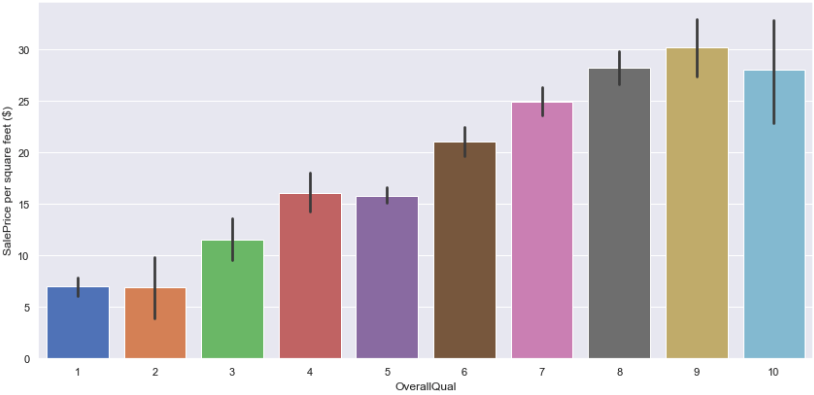
The better the overall material is, the more expensive the lot is. The interesting point is the median value of square feet price of “very excellent” lot is a little bit lower than “excellent” ones, but its variance is more than others.
“SalePrice_per_squareFeet” vs. “RoofMatl”
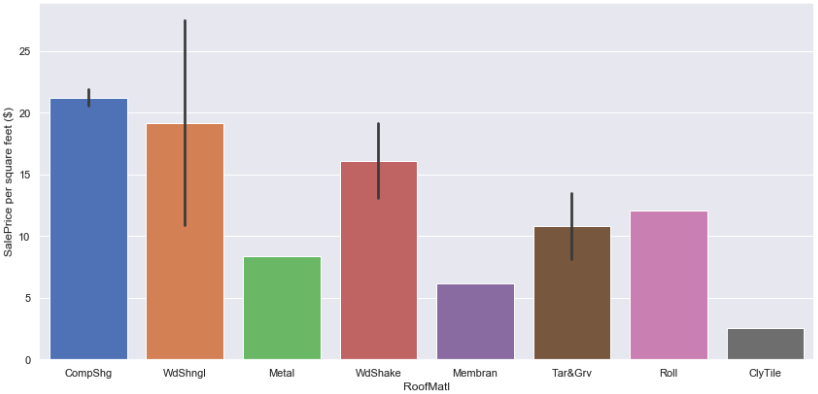
Considering the insulation, drainage, material cost and robustness, the lot with Standard (Composite) Shingle roof or Wood Shingles roof is more expensive than others. However, if a lot’s roof is constructed by Clay or Tile, it’s the relatively cheap (per square feet) since its function is not as well as others.
“SalePrice_per_squareFeet” vs. “Heating”
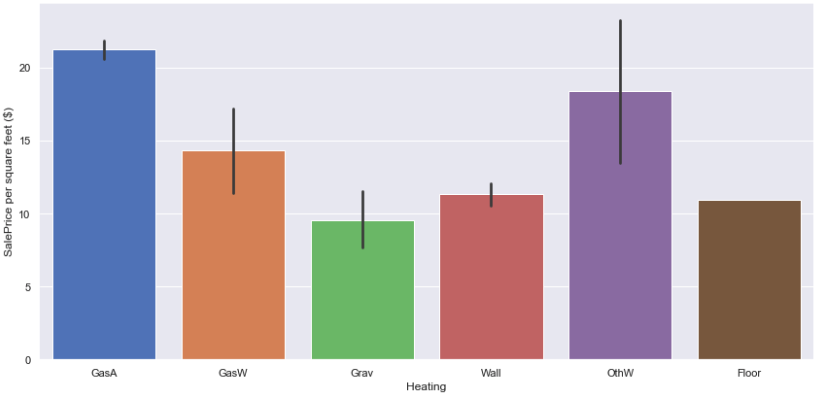
Considering material cost and construction-difficulties, the lot with “Gas forced warm air furnace” heating is more expensive than other heating types.
“SalePrice_per_squareFeet” vs. “GarageType”
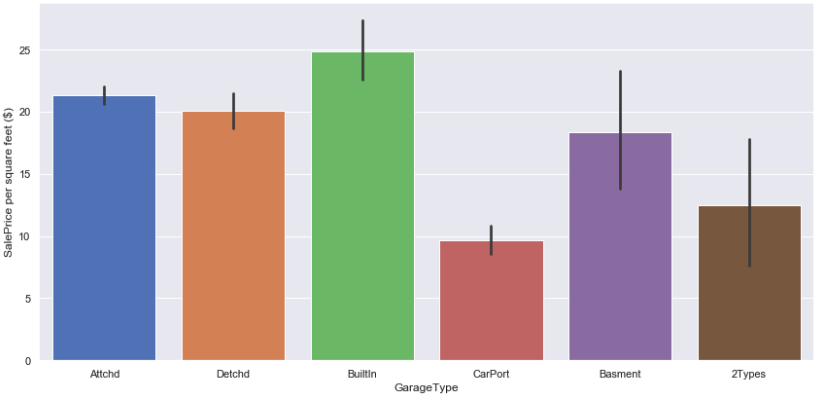
Considering construction and property’s convenience, the lot with built-in garage is more expensive than other types of garage, the lot only with car port as the garage is the cheapest in terms of per square feet’s price.
“SalePrice_per_squareFeet” vs. “SaleType”
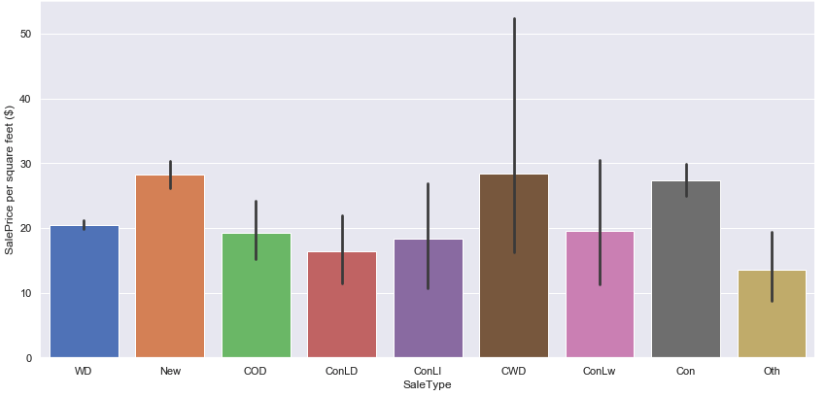
Let’s talk about the impact of sale type on the sale price. There is no doubt that the new lot which is just constructed and sold is the most expensive because its loss is the least. But I’m not clear for the reason of why other types of sale are less expensive. If you know why, your ideas are welcome :)
“SalePrice_per_squareFeet” vs. “SaleCondition”
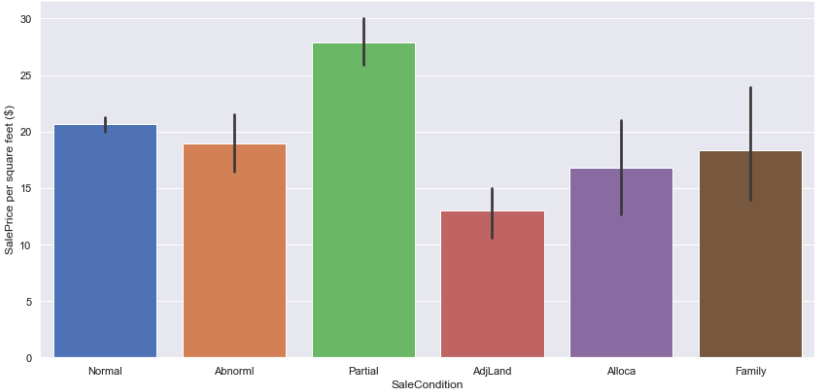
Among all sold lots, a lot is more expensive than others if it was not completed when last assessed (associated with New Homes), but it’s less expensive for the adjoining land purchase.
Train models
I trained data with Linear Regression, Ridge Regression, Lasso Regression and Elastic Net (with and without with cross-validation), also SVR, Gradient Boosting Regressor, XGBoost Regressor, and compared their accuracy score.
Finally I chose XGBoost Regressor to predict house prices in test dataset.
You can find all codes in this notebook.
Reference
- Kaggle Competition: Titanic: Machine Learning from Disaster
- Stacked Regressions to predict House Prices
- nattanan23, “Money home coin investment”, pixabay.com. [Online]. Available: https://pixabay.com/photos/money-home-coin-investment-2724235/